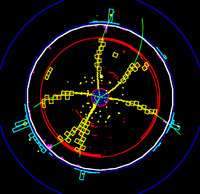CLEO

A D-Dbar event in the CLEO-c detector.
The
CLEO Collaboration operated the CLEO high-energy physics detector for nearly thirty years, from 1979 to 2008, recording the particles produced in electron-positron collisions at the
Cornell Electron-positron Storage Ring (CESR). CLEO carried out a broad physics program of studying the production and decay of bottom and charm quarks, as well as tau leptons, in order to probe the strong and weak nuclear forces and to search for new phenomena beyond the Standard Model of particle physics. To meet the evolving needs of this wide-ranging physics program, the CLEO detector underwent five major upgrades, each time incorporating new technologies in particle detection and identification, as well as implementing advances in computing and software.
CESR and CLEO Timelines
CESR
- 1975: CESR propsal submitted to NSF
- 1977: NSF funding approved
- 1979: First circulating e- beam and first e+e- collisions
- 1981: Mini-beta focusing at interaction region
- 1984: Multiple bunches in pretzel orbits
- 1988: Luminosity exceeds 1032 / cm2 / sec
- 1994: Crossing angle and bunch trains
- 1999: Superconducting RF cavities
- 2003-04: CESR-c superferric wigglers
CLEO
- 1975: "South Area Experiment" group conceives CLEO
- 1979: First data collected
- 1980: B meson discovered
- 1983: Ds meson discovered
- 1986: CLEO II detector with Csl calorimeter installed
- 1989: b → u transitions discovered
- 1993: b → s penguin decays discovered
- 1995: CLEO II.V with silicon vertex detector installed
- 1999: CLEO III with RICH installed
- 2003: CLEO-c data collection started
- 2004: hc discovered and D+ meson decay constant measured
- 2008: Running ends on March 3rd
- 2009: 500th paper published
Further Information

